Senator Michael Bennet
Att: John Whitney
835 East 2nd Ave
Suite 206
Durango, CO 81301
Senator Cory Gardner
Att: Betsy Bair
400 Rood Ave,
Federal Bldg.- Suite 220
Grand Junction CO 81501
Congressman Scott Tipton
Att: Brian Meinhart
225 North 5th Street
Suite 702
Grand Junction, CO 81501
Re: San Juan Wilderness Proposal
Dear Senator Bennet;
Please accept this correspondence as the comments of the above referenced Organizations vigorously opposing the San Juan Wilderness Proposal hereinafter referred to as “the Proposal”. After a detailed review of the proposal, the Organizations have concluded that every area expanded or created in the Proposal would result in significant lost recreational opportunities for the overwhelming portion of visitors to the Proposal area, both currently and in the future. While there are significant lost opportunities there is also no additional protections for multiple use routes that might remain outside the Wilderness areas and no new areas are designated for OHV recreation. Generally, the maps surrounding the Proposal are of low quality and make any meaningful review of possible impacts difficult if not impossible for the public to undertake. The Organizations also still fail to understand the management concerns or perceived threats that are driving the discussion around the need for additional protection of these areas.
Compounding our concern about the Proposal is the fact that many of the areas now proposed to be designated as Wilderness were specifically released back to multiple management as part of the 1980 Colorado Wilderness Act. This is highly frustrating as the Organizations were actively involved in the development of the Hermosa Watershed Legislation where large and diverse community support was developed around the Hermosa Legislation and a wide range of protections for a diverse group of users was achieved. The Organizations had hoped the Hermosa legislation was a new model for developing land use legislation but that does not appear to be 2
the case as the Proposal would immediately undermine protections of multiple use interests that were passed in 2014 and only recently implemented by the USFS.
Before the Organizations address the specific impacts of the Proposal to recreational access to areas previously released from possible Wilderness designation by Congress, the Organizations believe a review of four landscape level topics around Wilderness designations must be addressed as there is significant new research that weighs heavily against proposed designations and management restrictions. These four topics are:
- The imbalance of demand for Wilderness recreation with the opportunity provided in the planning area;
- The cost/benefit of providing recreational opportunities in the Proposal areas that have been heavily impacted by poor forest health;
- The inability to understand the management concerns that are driving the perceived need to designate these areas as Wilderness; and
- The significant negative economic impacts that result to local communities from Wilderness designations.
Prior to addressing our specific concerns around the Proposal, a brief summary of each Organization is needed. The Colorado Off-Highway Vehicle Coalition (“COHVCO”) is a grassroots advocacy organization advocating for the approximately 200,000 registered OSV and OHV vehicle users in Colorado seeking to represent, assist, educate, and empower all OHV recreationists in the protection and promotion of off-highway motorized recreation throughout Colorado. COHVCO is an environmental organization that advocates and promotes the responsible use and conservation of our public lands and natural resources to preserve their aesthetic and recreational qualities for future generations.
The Trail Preservation Alliance (“TPA”) is a 100 percent volunteer organization whose intention is to be a viable partner, working with the United States Forest Service (USFS) and the Bureau of Land Management (BLM) to preserve the sport of trail riding. The TPA acts as an advocate of the sport and takes the necessary action to ensure that the USFS and BLM allocate to trail riding a fair and equitable percentage of access to public lands.
Colorado Snowmobile Association (“CSA”) was founded in 1970 to unite winter motorized recreationists across the state to enjoy their passion. CSA advocates for the 30,000 registered snowmobiles in the State of Colorado. CSA has become the voice of organized snowmobiling seeking to advance, promote and preserve the sport of snowmobiling by working with Federal and state land management agencies and local, state and federal legislators. For purposes of these comments, TPA, CSA and COHVCO will be referred to as “the Organizations”.
1a. National trail opportunities and trail visitation are badly out of balance.
Prior to addressing the specific negative impact to all recreational opportunities that would result from the Proposal at a site-specific level, the Organizations believe it is important to establish a strong factual foundation for our concerns regarding recreational impacts from any Legislation that restricts multiple use access on public lands. The Organizations believe that any legislation must be based on best available science for management of the area to ensure that balance of goals and objectives and opportunities is achieved in the Legislation.
The first new piece of science and analysis that must be addressed in the Proposal is the imbalance in supply of trails in Wilderness when compared to the demand for these opportunities. The US Forest Service recently updated its National Trail mileage allocation, which is reflected in the chart below1:
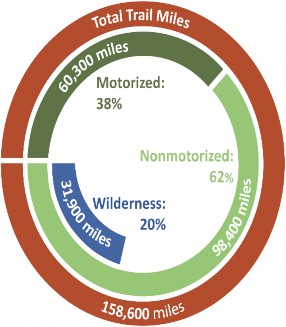
Our concerns regarding the imbalance in miles of routes and possible impacts from any further expansion of routes in Wilderness are based on a comparison of the 20% of all trails are currently in Congressionally Wilderness, which is badly out of balance with the levels of visitation to these areas on the national level. In 2016, the US Forest Service research indicates that while 20% of all trail mileage is located in a Wilderness area, these routes are visited by only 4% of all USFSvisitors.2 The Organizations simply do not believe that expanding this imbalance any further makes sense from a management perspective as 96% of USFSvisitation is being forced to recreate on a smaller and smaller portion of forests (80%). The Organizations believe this simply makes little sense as land managers should be seeking to provide the best opportunity for the largest percentage of visitors as all visitors to public lands should be treated equally. Additionally, with this inability to disperse use, impacts at developed sites will continue as more of the public will be forced to recreate on smaller and smaller portions of public lands in the Proposal area. Generally, the Organizations support allocations of resources based on demand for that resource and right now that relationship is simply badly out of balance with Wilderness based recreation.
1b. Local opportunities and visitation for trails is even more out of balance than nationally.
When USFS research is reviewed to determine recreational visitation to the land management offices involved in the Proposal area, it is determined that 6.7% of all visitors to the San Juan National Forest reported visiting a Congressionally Designated Wilderness area, 3 despite more than 700,000 acres of the San Juan NF 1.8 million acres (38%) being currently designated as Wilderness areas.4 This low level of visitation to the San Juan National Forest is compounded by the fact that the SJNF has several Wilderness areas that are experiencing comparatively high levels of visitation, such as the Weminuche. In order to balance this relationship, the Organizations submit there has to be large numbers of Wilderness areas designated on the SJNF that see almost no visitation throughout the year. As a result, the Organizations must question any factual basis that would assert recreational benefits from the Proposal, as currently there is almost twice the national average for Wilderness recreational opportunities but the usage of these opportunities is well below the national average.
Given the current imbalance of recreational demand with opportunities, both nationally and locally, the Organizations must question any assertion of a recreational benefit that could result from the Proposal, as currently these types of opportunities are horribly out of balance in the planning area when the supply of routes and trails is compared to the exceptionally low visitation overall. Rather that expanding opportunities for recreation on the forest, the Proposal would result in an even greater imbalance in usage than is currently on the SJNF.
1c. Forest Health, Recreation and Trails.
The Organizations are very concerned about the general scientific basis for the designation of any areas as Wilderness, as we are generally unsure of what management concerns are believed to be the basis for the special designations in the Propsoal. Without a clear management need, any discussion around the designations is difficult at best and the Organizations must question why such management changes would be undertaken. Our research indicates that the areas proposed for some type of Wilderness or Special Management Area type authority are some of the hardest hit areas in the nation when forest health issues are addressed. That weighs heavily in our position against the Proposal as it has been our experience that these are areas badly in need of active management for forest health issues. These treatments could quickly mitigate fire risks in impacted areas and speed restoration of these acres to healthy and vibrant habitat for a wide range of species. These negative impacts to treatment abilities should not be overlooked.
The Organizations are aware that both Senator Bennet has been very supportive of federal actions to address poor forest health conditions in Colorado, such as the Senator championing of wide revisions to USFS contracting authority to address forest health issues in the 2012 Farm Bill and his offices efforts to move firefighting budgets out of the USFS budget and into FEMA management. The Organizations vigorously support and appreciate these efforts but must ask why this issue and concerns expressed in other legislation have not been addressed with the creation of the Proposal in order to minimize possible conflict between management guidance that is provided in these pieces of legislation.
The scale of the management challenge surrounding poor forest health is an issue where significant new research has been provided by land managers seeking to address this issue, and the conclusions of this research provide a compelling basis to avoid further management complexity on this issue. In 2015, the USFS completed national level research projecting the impacts of poor forest health on the national forests over the next 25 years and unfortunately the federal resources in the state of Colorado did very poorly in this analysis as:
– the State of Colorado was identified as 5th in the country in terms of acres at risk due to poor forest health5;
– both Rocky Mountain National Park and Great Sand Dunes NP were both identified as two of the hardest hit national parks in the Country6; and
– Colorado National Forests dominated the list of those forests hardest hit by poor forest health in the country as 5 of the top 7 hardest hit forests are immediately adjacent to the areas to be designated as Wilderness.7
It is unfortunate that Colorado does so well in these types of comparisons and analysis and the Organizations submit Colorado must be striving to resolve these issues rather than making these challenges more difficult. This type of research provides significant credible foundation for serious concern around a scientific basis for the Proposal and significant conflicts in national management standards implemented to address landscape issues and the site specific standards in the Proposal.
Newly released joint research from the USFS and Colorado State Forest Service research provides the following graphical representation of the poor forest health in the vicinity of the proposed Wilderness and management areas as follows: 8
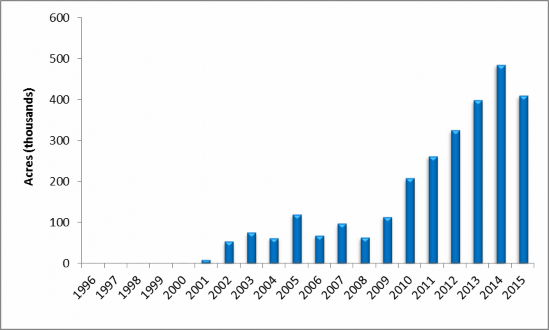
Figure 3. Annual acres affected by spruce beetle in Colorado.

Figure 4. Spruce Beetle activity in Colorado 1996-2015.
The Organizations believe that the poor forest health throughout the western United States is the single largest challenge facing public lands in our generation. Given that the areas proposed to be managed as Wilderness or other special management designation are in the hardest hit areas in the state for tree mortality, the Organizations believe that the first question with any legislative action must be:
“How does this Legislation streamline land managers ability to respond to the poor forest health issues in the area?”
The Organizations vigorously assert that the Proposal is a major step in the wrong direction when addressing the ability of land managers to respond to the forest health concerns in these areas, as rather than streamlining the response to poor forest health issues, most areas are functionally precluded from management. Even where management is allowed the Proposal, the Proposal would result in another layer of NEPA analysis that would need to be completed prior to any management of the issue. Requiring yet another layer of NEPA from land managers who are seeking to address this issue makes little sense and the abnormally severe wildfires that result from poor forest health often render recreational access to burn areas unavailable for decades. 8
Many of the routes impacted by the 2002 Hayman Fire have only been recently reopened and many of the routes impacted by the 2012 Waldo Canyon Fire will remain closed for many years to come.
While the graphical representation of the poor forest health in the area of the Proposal is compelling, the scope of these impacts is even more compelling when reviewed in terms of the sheer scale of the issue. The scale of the challenge was clearly identified in new research from the 2016 Colorado State Forest Service’s annual forest health report. The highlights of the 2016 report addressing the sheer scale of impacts are as follows:
- 8% of ALL trees in Colorado are dead and the rate of mortality is increasing;9
- the total number of dead trees has increased 30% in the last 8 years;10
- Research has shown that in mid-elevation forests on Colorado’s Front Range, hillslope sediment production rates after recent, high-severity wildfire can be up to 200 times greater than for areas burned at moderate to low severity.11
- A 2011 study involved monthly monitoring of stream chemistry and sediment in South Platte River tributaries before and after fire and showed that basins that burned at high severity on more than 45 percent of their area had streams containing four times the amount of suspended sediments as basins burned less severely. This effect also remained for at least five years post-fire.12
- High-severity wildfires responsible for negative outcomes are more common in unmanaged forests with heavy fuel loads than in forests that have experienced naturally recurrent, low-intensity wildfires or prior forest treatments, such as thinning. It is far easier to keep water in a basin clean, from the source headwaters and through each usage by recipients downstream, than to try and restore water quality once it is degraded..13
- During 2016’s Beaver Creek Fire, which burned 38,380 acres northwest of Walden, foresters and firefighters were given a glimpse into likely future challenges facing wildfire suppression and forest management efforts. These include longer duration wildfires due to the amount and arrangement of heavy fuels. Observations from fire managers indicated that instead of small branches on live trees, the larger, dead fuels in jackstraw stands were the primary driver of fire spread…. “The hazards and fire behavior associated with this fuel type greatly reduce where firefighters can safely engage in suppression operations”14
The concerns raised in the Colorado State Forest Service research are by no means an anomaly. Wilderness and improperly managed Roadless areas were previously identified by the Forest Service as a significant factor contributing to and limiting the ability to manage the mountain pine beetle epidemic and poor overall forest health. The 2011 USFS research prepared at the request of then Senator Mark Udall’s office on this issue clearly concludes as follows:
“The factors that limited access to many areas for treatments to maintain foreststands—steep slopes, adjacency to inventoried roadless areas, prohibition of mechanical treatments in designated wilderness—are still applicable today.”15
The Udall Forest Health report continues on this issue as follows:
“• Limited accessibility of terrain (only 25% of the outbreak area was accessible due to steep slopes, lack of existing roads, and land use designations such as wilderness that precluded treatments needed to reduce susceptibility to insects and disease).”16
This report is not discussed at length in these comments as previous comments have addressed this report. Since the release of this Forest Service report, additional Colorado Forest Service researchers have reached the same conclusions as the USFS Research Station did in the Udall Forest Health Report. The Colorado State Forest Service’s 2011 Forest Health report specifically identifies a major contributing factor to the spruce beetle outbreak as:
“Outbreaks typically occur several years after storms cause windthrow in spruce trees, which are susceptible to blowdown because of their shallow root system.Spruce beetles initially breed in the freshly windthrown trees, and subsequent generations attack and kill live, standing trees.”17
The lack of access to Wilderness areas to manage blow down areas is specifically identified as a major limitation in forest managers ability to address spruce beetle outbreak. These blow downs are directly identified as causing the spruce beetle outbreaks. The 2011 State Forest Service report specifically states:
“Many areas where spruce beetle outbreaks occur are remote, inaccessible or in designated wilderness areas. Therefore, in most cases, foresters can take little or no action to reduce losses caused by this aggressive bark beetle. However, individual trees can be protected on some landscapes.”18
The Organizations must note the 2011 State Forest Service report extensively discussed how EVERY major spruce beetle outbreak in the state of Colorado was associated with a major wind event in a Wilderness area, which could not be managed by foresters due to Wilderness designations. Given the clear conclusions of best available science, that Wilderness and other management restrictions are contributing to and limiting the ability of land managers to respond to the single largest management challenge that will be experienced in our generation, the Organizations must question why such a decision to further limit the authority of land managers to respond to this challenge would ever be made. Such a position would not be based on best available science and could negatively impact a wide range of recreation opportunities both inside and outside the newly designated Wilderness areas.
1c. Wildlife habitat is degraded when management authority is restricted.
18 See, Colorado State Forest Service; 2011 Report on the Health of Colorado’s Forests; at pg. 11.
The Organizations are aware that generalized statements that the Proposal would improve wildlife habitat in the areas have been relied on previously, but the Organizations are not aware of any scientific basis for such a position. The Organizations are concerned about wildlife impacts due to the fact that many of our members are hunters and fisherman and directly benefit from healthy wildlife populations in the area. In addition to these consumptive wildlife concerns, many of the public are non-consumptive users of the large wildlife populations in the Proposal area and are provided a superior recreational experience from the large and healthy wildlife populations in the proposal area. The Organizations would also note that the delisting of any endangered or threatened species is often heavily reliant on a stable and healthy habitat for the species, and this is not provided by lands heavily impacted by poor forest health issues. Delisting of threatened or endangered species must also be considered in any management decisions as well, as degraded habitat will make species recovery more difficult both inside and outside any special management area designations.
The Organizations wish to highlight several new pieces of research that address the need for active management of public lands and the need for a healthy forest for wildlife in the planning area. In 2015, Colorado Parks and Wildlife released its State Wildlife Action Plan(“SWAP”), which provided a brief summary of the challenges facing species of conservation concern and threatened and endangered species in the State of Colorado. The SWAP provides the following summary of the impacts to wildlife at the landscape level from poor forest health:
“Timber harvesting within lodgepole pine at the appropriate sites and scale is needed to maintain pure lodgepole pine stands for lodgepole obligate wildlife species. Continuing to increase stand heterogeneity to reduce large, continuous even-aged stands will help reduce risk of uncharacteristic wildfire and large-scale pine beetle outbreaks in the future.”19
In addition to the above quote addressing the landscape level concerns around poor forest health, more than a dozen species are identified where the degradation of habitat due to beetle kill was specifically identified as a significant threat to the species.20 These types of concerns and impacts are simply not resolved with additional restrictions on the ability of land managers to respond to the forest health challenges. Management must remain on target in addressing these challenges in order to respond to these unprecedented tasks in the most cost effective and timely manner possible.
In addition to the newly released SWAP, significant new research has been provided that clearly identifies the need to address poor forest health concerns for many other species. Forest fires have been identified as a major threat to habitat for the Endangered Colorado Cutthroat trout, both during the fire itself and from the condition of riparian area after a fire. The Forest Service species conservation report specifically states:
“Lack of connectivity to other populations renders them vulnerable in the short term to extirpation from natural disturbances such as fire, post-fire debris torrents, or floods….”21
The Conservation Report also noted the significant impact that woody matter has on the cutthroat trout habitat. The Conservation Report notes the impact of fire and insect infestation are both major impacts on woody matters stating:
“large wood (also known as coarse woody debris) plays a dominant role in many montane streams where greenback cutthroat trout persist. Deposition of large wood affects sediment scour and deposition, energy dissipation, and channel form (Montgomery et al. 2003), and creates pools, stores spawning gravels, affords overhead cover, and provides refuge during high flows…… Inputs of large wood are controlled by a variety of processes. Mass mortality of riparian stands from fire, insect damage, or wind is important sources.” 22
Fire is specifically identified as a disturbance that results in trout habitat being unsuitable for centuries, stating:
“In particular, disturbances that dramatically alter channels or riparian zones—debris torrents…and severe fires—will change the discharge-sediment transport regime, re-set forest succession and large wood dynamics, and redistribute suitable and unsuitable habitat in a basin, sometimes for decades or centuries…” 23
This research notes the significant difference in impact to the cutthroat trout between conditions existing before the fire, during the fire and after the fires that are now occurring at unprecedented levels from the poor forest health existing in Colorado Forests. Given that the Colorado River Cutthroat Trout is one of dozens of fish species currently at risk due to the poor forest health on the SJNF, the Organizations submit best available science for species management weighs heavily against any expansion of Wilderness like management in the planning area.
2a. All recreational opportunities would be exceptionally impacted due to extensive restrictions on how basic maintenance of routes may be performed in new Wilderness areas.
Given the Proposal has asserted to be driven by recreational interests, the Organizations believe this issue warrants a more complete review and analysis of impacts and benefits from the Legislation at a more localized level than the national update on recreation that was previously provided. This is another issue where the benefits of the Legislation are unclear. While the benefits are unclear, the significant negative impacts are immediately clear as any efforts to provide basic maintenance and management of existing opportunities in the areas where Wilderness management is expanded become far more difficult and available funding is significantly diminished.
It has been the Organizations experience that land managers are struggling badly with providing basic maintenance and safe access to existing recreational opportunities in the planning area even when mechanical means and tools are available to maintain these areas. This is simply due to the large number of falling trees that block or otherwise impact recreational routes in the area. As the Organizations have previously noted, Colorado is some of the hardest hit areas in the Country in terms of poor forest health and logic would conclude that recreational management challenges would also be the largest in Colorado in allowing recreational usage of beetle kill areas. The challenge is immense even with the most advanced mechanical maintenance equipment available and is realistically beyond cost effective management without mechanical maintenance equipment. While the OHV/OSV community provides a large amount of maintenance resources for trails outside Wilderness areas, these resources are often matched with agency funding and the benefits are expanded on the ground. When agency resources are limited for maintenance, it impacts the entire management area regardless of Congressional designations.
While the Organizations are aware that stating the maintenance challenges facing managers relating to recreational routes and facilities are immense has some level of value, there is also no replacement for hard numbers when assessing impacts. New research has been performed by the USFS in the State of California regarding the scope of the challenges facing land managers in maintaining recreation on three Southern California Forests heavily impacted by poor forest health. The USFS conclusions on these forests are as follows:
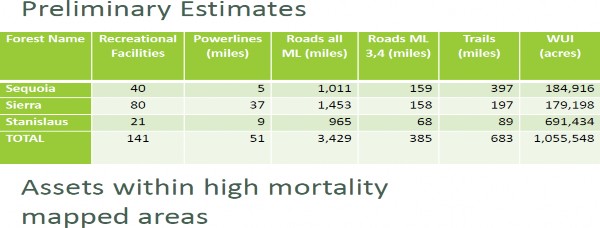
The Organizations believe any assertion that maintenance of existing recreational opportunities and resources encompassing more than 4,000 miles of roads and trails and 141 recreational facilities impacted by poor forest health without mechanical assistance would lack factual or rational basis. This type of challenge is even more difficult in Colorado as research previously identified finds that Colorado forests are significantly harder hit than the three forests in California that are the target of the above research. The Organizations are intimately aware that existing resources for maintenance of recreation facilities and routes in Colorado struggle badly to maintain opportunities with mechanical resources and management being allowed.
In this situation the Organizations must question why streamlining the land managers ability to provide safe high quality recreational opportunities is not the priority of the Legislation. Instead of streamlining efforts, the Legislation provides a new and significant barrier to land managers responding to the issue. While these comments are centering on the maintenance impacts from poor forest health, there are numerous other challenges in providing basic maintenance such as rock removal, which in a Wilderness must be done by hand instead of mechanized equipment and simply transporting equipment to sites, which must be done by hikers or horseback instead of with trucks and trailers. This review is needed in order to fully understand the basis of our concerns around overall impacts to recreation and federal budgets that are required to fund maintenance with exceptionally expensive methods.
The most common manner of removing downed trees or hazard trees in a Wilderness based recreation area of Colorado is with a large cross cut saw operated by two people such as that pictured below: 25
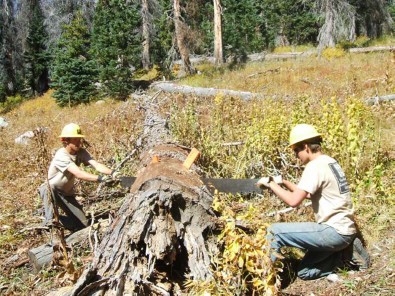
Removing a tree such as that pictured above could be achieved in under an hour with mechanical means, but a similar removal could easily take all day without mechanical assistance. While a manual cross cut saw might be able to deal with isolated trees, such as these pictured above, the removal of hazard trees such as those photographed below are far more problematic.
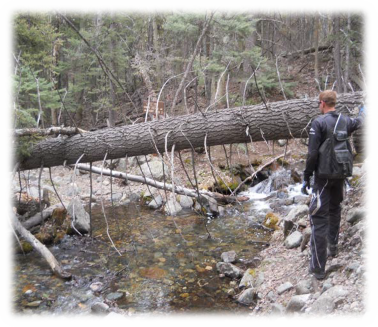
The ability to safely removal a tree blocking a route in the manner pictured above is difficult even with mechanized assistance but becomes far more concerning when hand tools must be used simply due to the extended amount of time sawyers must be in proximity to the hanging tree and the fact that twice as many sawyers are needed for the removal of the tree. Even when dealing with an isolated tree crossing a trail, costs and risks associated with basic maintenance are greatly increased with the prohibition of mechanical upkeep and this results in significant limitations on all maintenance activity in the planning area.
While there are concerns about the safety and cost of maintenance of Wilderness routes on a per tree level, concerns are expounded when maintenance is needed around larger wind events or larger scale tree fall issues such as those now commonly seen in beetle kill areas in the state. As a result of the serious limitations on how basic maintenance can be performed for major events like the blowdown that is currently blocking all public access to the Hunts Lake Trail on the Pike San Isabel photographed below are almost prohibitions on reopening routes:
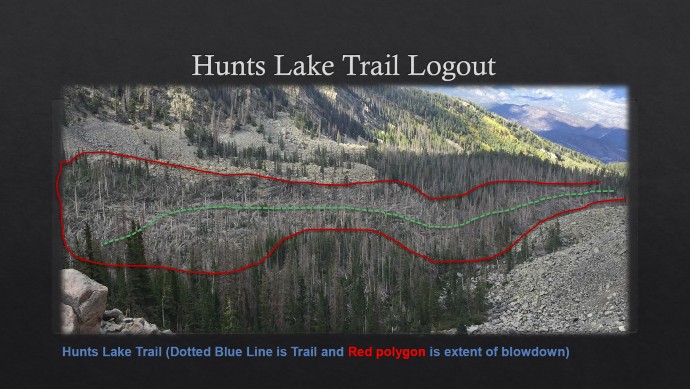
Reopening of the Hunts Lake Trail would be a significant challenge with mechanized assistance but removing this number of downed trees without mechanical assistance would result in something that is a significant challenge to a project that might easily take months or years of effort if weather was uncooperative. These types of secondary impacts from Congressional action should not be overlooked as these impacts reduce funding available for any recreational management in the planning area.
Ignoring these types of on the ground impacts from expansion of management restrictions from the Proposal makes little sense and erodes any basis for claiming recreational benefits from the Proposal. There is simply limited funding available for recreation and that money must be applied in the most effective manner possible to protect existing recreational opportunities both inside and outside of Congressionally Designated Wilderness areas.
2b. Trail maintenance resources are greatly reduced in Wilderness areas.
As the Organizations have noted already, costs associated with basic maintenance of recreation facilities and opportunities are significantly increased with any Wilderness designations. Based on the Organizations experiences with the Colorado State Trails Programs grants, Wilderness Trial Maintenance costs are consistently identified as being something to a factor of 100x the cost of mechanized trail maintenance in grant applications to partner programs. The average mechanized maintenance crew can easily clear and maintain 100 to 200 miles of trail per year, while similar levels of funding and partner efforts utilizing non-mechanized means can only address 1-2 miles of trail per year. The cost benefit relationship is simply not comparable.
In addition to the exponentially increased costs of maintenance for recreational opportunities in Wilderness area, the amount of funding that is available for maintenance is greatly reduced. The USFS estimates the $4.3 million in funding available from the State of Colorado’s voluntary OHV registration program almost doubles the amount of funding available for summer recreational maintenance programs as follows:

This disparity of funding is even more problematic when the more than $1.5 million in additional maintenance funding that results from the Colorado Voluntary Snowmobile Registration Program is included in this equation. Often winter grooming activities are maintaining routes throughout the winter that are used throughout the year and result in trees being removed throughout the year rather than only during the summer season.
The direct impacts of the voluntary OHV/OSV program funding are:
- EVERY Ranger District in the State of Colorado has access to a well-equipped trail maintenance crew funded by the voluntary OHV tax on a prioritized basis;
- Most ranger districts have a dedicated motorized trail crew for summer maintenance; and
- Most Ranger Districts also a winter maintenance crew from snowmobile registration funds.
The availability of these crews directly contrary to the national situation facing the forest service where most Ranger Districts have no maintenance crews at all. While these teams have been hugely successful, their effectiveness is restricted by available funding limits and when existing resources are used for maintenance in ways that are 100x less effective it impairs recreational experiences for all the public, not just those choosing Wilderness based recreation. The Organizations believe that any legislation addressing recreational access and maintenance must be looking at how to making existing funding go further, rather than making existing funding less effective by a factor of almost 100, as is the result of Wilderness recreation.
Why are the economic resources available for maintenance of Wilderness recreation a concern for the Organizations, as our activities have been prohibited? While the voluntary OHV and snowmobile funds greatly expand the resources that are available to land managers for maintenance of facilities outside Wilderness areas, these resources are often leveraged with USFS budgets for maintenance of these areas. When the match to the funds provided through the voluntary OHV funds is asked to become less effective by a factor of as much as 100 for the benefit of less than 4% of all visitors to USFS land, the Organizations are immediately concerned that the match to the OHV program funds will be reduced. This reduction is concerning as no additional benefit is achieved with these funds but resources being leveraged for maintenance outside Wilderness are significantly reduced and the Organizations are intimately aware that these funds are often stretched very thin already. This is simply unacceptable to the Organizations.
3. Economics Contributions of Wilderness Recreation.
The Organizations are aware that many counties in the planning area have moved away from the dark economic times that plagued them several years ago. Unfortunately many communities outside the direct influence of ski area-based revenue continue to struggle and overly rely on recreational opportunities to provide basic services to residents. Many of these communities might include Mancos, Placerville and Rico as examples. Given the importance of recreation to these communities and that many of our members that live in these communities, the Organizations believe a brief update of the economic impacts to these communities that resulted from the Proposal is warranted. Significant new information identifies the strong negative relationship between Wilderness designations and local economic activity involving recreation.
The first piece of new scientific research is the local economic information from USFS, as part of their “at a glance” summaries for the San Juan National Forest, which identifies the overwhelming importance that recreation plays in the success of local communities. The USFS summarizes their conclusions in the following graphs27:

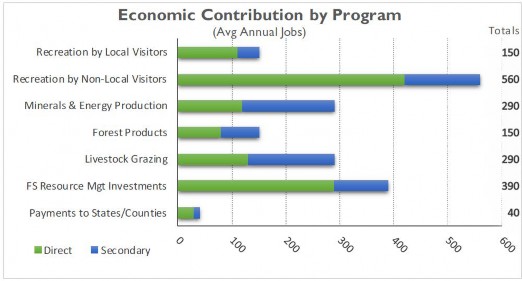
It is difficult to understate the importance of the economic contribution of recreational activity to local communities, as economic benefits of recreation and FS management of recreational facilities outpace all other activities combined on the SJNF.
New research highlighting the economic importance of multiple use recreation to the recreational spending benefits flowing to local communities comes from research from the Department of Commerce. This analysis was prepared at the request of Department of Interior Secretary Sally Jewel in 2012, addressing the importance of recreational spending in the Gross Domestic Product.28 This research clearly identified the important role that motorized access plays in recreational spending, which is summarized in the following chart:

This research concludes that motorized recreation outpaces the economic contribution of boating and fishing at almost twice the rate and that motorized recreation almost outspends all other categories of recreation combined. Given that motorized usage plays major roles in both the hunting and fishing economic analysis, the three largest components of economic benefit from recreational activity would be prohibited in a Wilderness area. As a result of the overwhelming nature of these conclusions, the Organizations have to express serious concerns when the lion’s share of economic drivers are excluded from using any portion of public lands as clearly economic benefits are limited. The negative economic impact concerns regarding degrading multiple use access are immediately apparent.
The risk of negative economic impacts is also highlighted in newly released research from the US Forest Service, which estimates that recreation on National Forest Service Lands accounts for more than $13.6 billion in spending annually.29 Experts estimate that recreational spending related to Wilderness areas accounts for only 5% of that total spending or approximately $700,000 million nationally. 30 The limited economic driver of Wilderness based recreation is compounded by the fact that more than 20% of the trail network that is currently located on USFS lands is within Wilderness areas. Again, this type of underutilization of any recreational resource is concerning to the Organizations simply because of the allocation of the resources and funding.
The economic underutilization of Wilderness based recreational resources is easily identifiable when economic activity of recreational users is compared. This research is summarized below:31
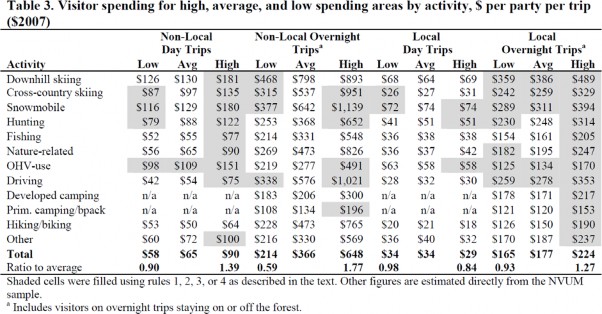
We will not be addressing this research at length as we have included this analysis in our previous comments on earlier versions of this legislation, other than to note the conclusions of this research are consistent with conclusions that high spending user groups, such as snowmobile and OHV users are consistently excluded from Wilderness areas, while low spending groups such as cross-country skiers and hiker are permitted in these areas. Given the fact that low spending profile users are often spending only 20% of higher spending profile groups, these conclusions are consistent with the conclusions of both the Department of Commerce and new USFS research.
While the imbalance in spending profiles is problematic, the fact that once Wilderness is designated the general public fails to use the limited recreational opportunities in these areas is even more concerning. Nationally, Congressionally designated Wilderness accounts for approximately 19% of USFS lands but results in only 3.4% of all visitor days.32 In the State of Colorado, there is approximately 22% of USFS lands managed as Wilderness33 but despite the expanded opportunity results in only 6.7% of visitor days on the San Juan National Forest.34 As we have noted in previous comments there are significant declines over time in the visitation to and demand for Wilderness based recreational experiences. Given the significant underutilization of Wilderness resources in the area of the Proposal, the Organizations must vigorously assert that any economic risk is significantly negative and must be addressed or at least recognized by the communities in the vicinity of the Proposal areas.
4a. Many of the areas now proposed for Wilderness designation have a long history of being found unsuitable for designation.
Many of the areas to be added to the Wilderness system in the Proposal have been the basis of ongoing discussions for possible Wilderness designations since the RARE inventories were conducted in the 1970’s. While many of these areas were found suitable for inclusion and added to the Wilderness System in 1980, the areas within the current Proposal have been consistently identified as unsuitable for designation for a variety of reasons and were specifically released from possible future designation by the same legislation. As a result, the Congressional standards addressing the need for multiple use management of these areas must not be overlooked as this was the balance that was struck for these areas previously. The rather systemic lack of regard for consensus positions could not be reflected more perfectly than by the fact that the Proposal seeks to overlook the 1980 Colorado Wilderness act and already seeks to alter the consensus position that was achieved with the Hermosa Watershed Legislation in 2014. This is exceptionally troubling as the USFS has only completed planning required for the Hermosa area less than a year ago.
In this portion of our comments, the Organizations wish to highlight the repeated exclusion of many areas now sought to be designated as Wilderness from lower levels of management inn previous administrative reviews mandated by Congress. The systemic conclusions that many of these areas were never suitable for inclusion in the Wilderness system started with the RARE and RARE 2 inventories due to the high levels of existing usages of these areas included high levels of recreational value. These areas would include the Wilson Mesa area, Sunshine, Whitehouse, Liberty Bell and many other areas.35 While the site-specific information is available for review if your office should desire such a discussion, these conclusions are not discussed at length in these comments as they are repetitive to the conclusions of the Colorado Roadless Rule development in 2012. The Organizations must ask why these areas, which have never been suitable for designation as Wilderness, despite almost 50 years of inventory, would now be thought suitable for designation as Wilderness? The question about the need for Wilderness designations becomes more concerning when Congressional action has previously returned these areas to multiple use management.
4b. Most areas proposed to be Wilderness was found unsuitable for designation as Upper Tier Roadless areas in the 2012 Colorado Roadless Rule Process.
The Organizations were heavily involved in the development of the 2012 Colorado Roadless Rule, where both additional management flexibility was to be provided in Roadless areas and additional protection of less developed areas was explored. Extensive site-specific inventories of areas were again provided as part of development of the Colorado Roadless Rule to ensure that current information about any area was relied on in the inventory process. As a result of this process, significant portions of the areas now proposed to be Wilderness or the subject of other exclusionary management standard were inventoried for possible inclusion in upper tier roadless designations under the 2012 Colorado Roadless Rule development. Similar to the RARE inventory conclusions almost every area proposed to be Wilderness was found unsuitable for management as upper tier only a few years ago. The Organizations must question why the heightened restriction of Wilderness management is thought to be warranted, when lower levels of protection have already been identified as unsuitable several times.
In the Roadless Rule process, generally two categories of management inventory were explored, which were Colorado Roadless areas and Upper Tier Roadless areas. In an Upper Tier roadless area, management was closer to a Congressionally Designated Wilderness and in Colorado Roadless Area management direction was moved towards higher levels of usage and flexibility.
Under Alternative 2 (preferred) the designation of Upper Tier Roadless management is reflected in areas highlighted in yellow on the map below and alternative 4 of the Proposal provided a more extensive acreage of areas for possible upper tier designation, which is reflected in the red freckled areas on the map below. The stark differences between the scope of alternative 2 and alternative 4 of the inventory are reflected in the map below:
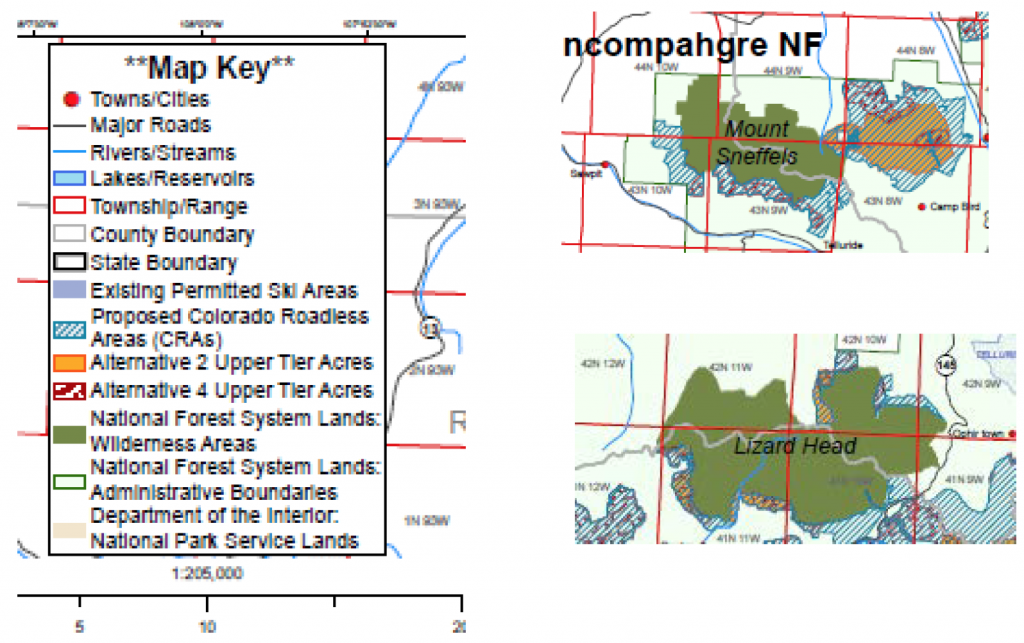
The Organizations must note that almost EVERY area now proposed to be Wilderness was reviewed under Alternative 4 of the Roadless Rule EIS and found to be unsuitable for this lower level of protection and management of an Upper Tier management designation. In the site-specific descriptions of each of these areas, a detailed discussion of the reasons for designation of these areas either as CRA or Upper Tier was provided. The overlap of the CRA process and RARE inventories conclusions is significant and weighs heavily against the legislation.
The Organizations must question any assertion that these areas are suitable for Wilderness designations, when these areas were recently inventoried and found unsuitable for the lower level of protection provided by an Upper Tier designation. Any assertion of factual basis for such management would not be supported by the extensive site-specific inventory and review that was created as part of the Colorado Roadless Rule development. The Colorado Roadless Rule process was another administrative confirmation that these areas do not warrant heightened protections and should be managed for multiple use.
5a. Previous Congressional protections of multiple use must be honored.
Prior to addressing the site-specific impacts to trails and access currently within the expanded Wilderness and SMA boundaries the Organizations believe a review of the existing protections of usages in the planning areas is an important component of why the Organizations are opposing the Proposal. The specific release of many of these areas back to multiple use management by previous Congressional action is an important component of any balance, however limited, to the 1980 legislation that moved many areas into Wilderness management in the planning area. The Organizations are unable to identify any reason to review these previous consensus positions and actions of Congress.
When both the Mt Sneffels and Lizard Head Wilderness Areas were designated as Wilderness in 1980, the following provisions were included in the preamble of that legislation:
“(3) the Department of Agriculture’s second Roadless Area Review and Evaluation of National Forest System lands in the State of Colorado and the related congressional review of such lands have also identified areas which do not possess outstanding wilderness attributes or which possess outstanding energy, mineral, timber, grazing, dispersed recreation and other values and which should not now be designated as components of the National Wilderness Preservation System but should be available for nonwilderness multiple uses under the land management planning process and other applicable laws.”36
The Organizations must question why areas that have been specifically released by Congress for multiple use management and consistently found unsuitable for designation as Roadless areas would ever be found now available for Wilderness designation. The Congressional release of roadless areas, such as Sunshine, Wilson Mesa, Whitehouse and Liberty Bell is highly relevant due to the proximity of many of the new proposed Wilderness Area additions to both the Mt. Sneffels and Lizard Head Wilderness and that these areas were specifically excluded by Congress from Wilderness management previously.
In addition to the recognition of multiple use management standards for many of the proposed Wilderness areas, the 1980 Colorado Wilderness Act also specifically identified that there should be no buffer around any of the newly designated Wilderness areas as follows:
“SEC. 110. Congress does not intend that designation of wilderness areas in the State of Colorado lead to the creation of protective perimeters of buffer zones around each wilderness area. The fact that nonwilderness activities or uses can be seen or heard from areas within the wilderness shall not, of itself, preclude such activities or uses up to the boundary of the wilderness area.”37
In addition to the specific provisions of the 1980 Colorado Wilderness Legislation clearly returning many of the areas to multiple use management, the Proposal also seeks to amend the management prescriptions recently passed as part of the Hermosa Watershed Legislation. This is highly frustrating as the Hermosa Legislation was the result of many years of collaborative efforts across a wide range of community interests including Senator Bennet’s Office. The immediate desire to change the Hermosa Watershed management is astonishing and simply provides another troubling example were consensus positions simply are not honored by those that actively participated in the process. If consensus positions are changed immediately after consensus management is implemented, the Organizations would question the value of the consensus process and note that the community support would be difficult to reconvene in the future on other issues. This should be avoided.
Congress has spoken regarding the management of these areas and the Organizations are unable to identify any reason to disturb these conclusions with this legislation. The Organizations submit that these provisions were designed to end discussions around possible designations and the Organizations submit that instead of providing Legislation designating these areas as Wilderness, any Legislation should be clearly identifying and protecting existing usages of these areas through an SMA type designation.
5b. Sheep Mountain SMA closes opportunities and would overturn consensus management positions reached in the Hermosa Watershed legislation of 2014.
The Organizations are vigorously opposed to what is a legislative attempt to designate 21,620 acres where permittees and guides would be provided superior rights of access over the public. This position is simply offensive. This exclusionary management is exceptionally painful for the usage of the area, where outfitter/guides would be provided by Congressional action the right to always allow their clients to get first tracks in any powder in the SMA as public access to exceptional winter motorized opportunities in the area would be lost but permitted heli-skiing operations would be permitted to continue. The Sheep Mtn. area has also been the basis of ongoing conflict between snowmobile users, who have legally used this area for decades and permittees. This area has historically provided high quality recreational opportunities for intermediate and advanced riders, which have been the target of consistent harassment about possible private land incursions made by land owners who have historically misstated property boundaries and asserted the area was closed by the USFS. USFS has worked with those landowners to try and provide accurate information but these efforts have had marginal success. The Organizations believe that these landowners are affiliated with business interests that are now seeking to apply the arbitrary exclusion standards in the SMA to close the area to public access. This simply compounds the vigor of the Organizations opposition to the SMA, as bad behavior and intolerance should not be rewarded with passage of federal law.
The lack of any rational basis for the Sheep Mtn. decision is highlighted by the fact that previous versions of the San Juan Legislation asserted a benefit to big horn sheep that might be in the area with the added SMA management. Such a position was removed when the public noted that big horn sheep response to a helicopter landing in the backcountry to drop off skiers would clearly be higher than any dispersed snowmobile type impacts simply due to the volume of sound produced by the helicopter.
In addition to providing a Congressional preference for permittees in the SMA area, the SMA would significantly alter many of the designations and decisions that were made in the Hermosa Watershed Legislation that was passed less than 3 years ago with broad community support and sponsored by Sen Bennet, Sen Udall and Congressman Tipton38. The desire to overturn a broadly supported piece of legislation such as the Hermosa Watershed Legislation highlights the need for a complete review of existing Legislative protections of lands in the Proposal area. The Organizations are deeply troubled that the San Juan Legislation would seek to overturn the clear mandates made in the Hermosa Legislation so quickly.
In addition to providing an offensive preference against public access to the Sheep Mountain SMA, there is an extensive multiple use trail network in the area that would be lost with passage of the SMA. Protection of these routes and areas was a major concern in the Hermosa Legislation. These networks are identified in the maps below.
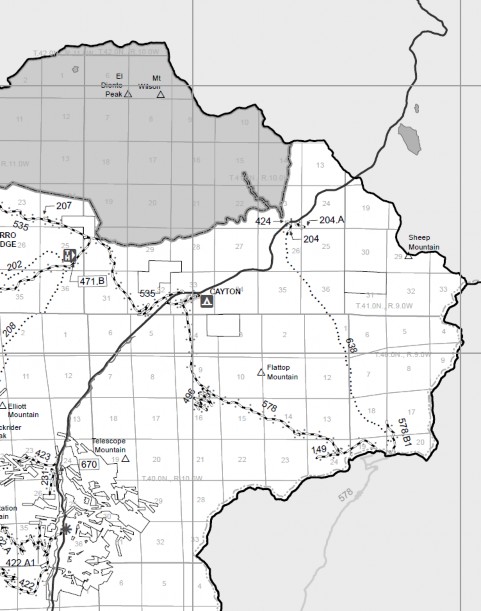
2014 Dolores Ranger District MVUM
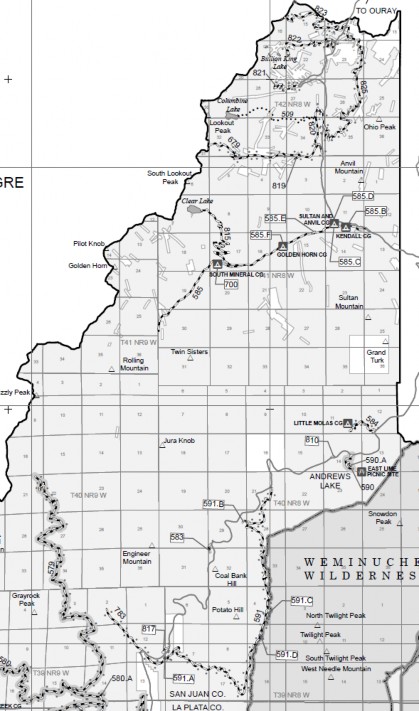
2014 Summer MVUM – Columbine Ranger District

2104 GMUG Mountain MVUM
In addition to the Sheep mtn area having extensive legal summer trails available, the entire area is legally open to OSV travel pursuant to the 1983 GMUG RMP as it is managed as 2a areas (semi primitive motorized) or 6b (grazing where semi primitive motorized and roaded natural will be provided)
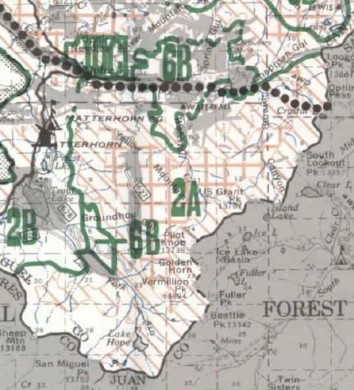
5c. Wilson Wilderness and Sunshine
The Organizations are opposed to the Wilson and Sunshine Area Wilderness additions due to the large number of trails and trailheads in this area that provide high quality multiple use recreational opportunities that would be lost. The previous Congressional action to protect these uses in these areas compounds the vigor of our Organizations opposition. These trail networks are represented in the Motor Vehicle Use Maps outlined below:
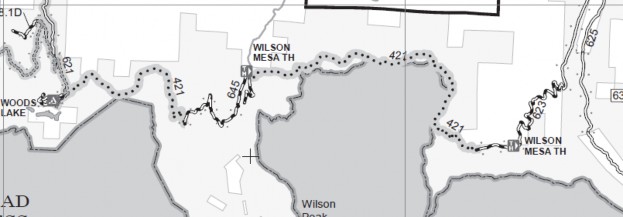
2014 Dolores Ranger District MVUM
5d. Whitehouse additions would close important trail networks in the area.
The Organizations are again opposed to the Wilson and Sunshine Area Wilderness additions due to the large number of trails and trailheads in this area that provide high quality multiple use recreational opportunities. The previous Congressional action to protect these uses in these areas compounds the vigor of our Organizations opposition. These trail networks are represented in the Motor Vehicle Use Maps outlined below:
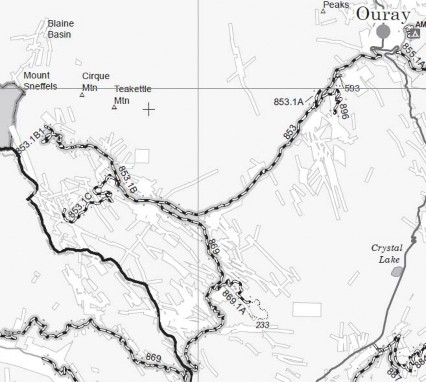
5. Conclusion.
After a detailed review of the Proposal, the Organizations have concluded that every area expanded or created in the Proposal would result in significant lost recreational opportunities for the overwhelming portion of visitors to the Proposal area, both currently and in the future. Rather than streamlining the management of these areas, the Proposal would create a major management barrier and greatly increase the costs of any management activities that might be undertaken in these areas. This will negatively impact recreational access both in the Proposal area and in areas that are outside the new management standards in the Proposal. While there are significant lost opportunities, there is also no additional protections for multiple use routes that might remain outside the Wilderness areas and no new areas are designated for OHV recreation.
The opposition to the Proposal is based on the consistent conclusions of decades of administrative review of these areas of these areas for possible designation by Congressional mandate. These areas have been consistently found ineligible for designation and specifically released back to multiple use. The imbalance of the current Proposal is compounded by the fact that the Proposal would alter the management prescriptions previously provided by Congress for protection of multiple uses in these areas both in the 1980 Colorado Wilderness Legislation and only recently passed as part of the Hermosa Watershed Legislation. This is highly frustrating as 33
the Organizations were actively involved in the development of the Hermosa Watershed Legislation where large and diverse community support was developed around the Hermosa Legislation and a wide range of protections for a diverse group of users was achieved. The Organizations had hoped the Hermosa legislation was a new model for developing land use legislation but that does not appear to be the case.
The Organizations still fail to understand the management concerns or perceived threats that are driving the discussion around the need for additional protection of these areas and after a review of best available science the Organizations can find no basis for the Legislation as the Proposal would provide a major barrier to the maintenance of recreational facilities in the planning areas.
Please feel free to contact Scott Jones, Esq. if you should wish to discuss any of the issues that have been raised in these comments further. His contact information is Scott Jones, Esq., 508 Ashford Drive, Longmont Colorado 80504; phone 518-281-5810; email Scott.jones46@yahoo.com.
Respectfully Submitted,
Scott Jones, Esq.
COHVCO/TPA Authorized Representative
CSA President
Don Riggle
Director of Operations
Trails Preservation Alliance
1 See, USDA Forest Service; National Strategy for a Sustainable Trails System; December 30, 2016 at page 2.
2 See, USDA Forest Service; National Visitor Use Monitoring Survey Results –National Summary Report–data collected FY2012 through FY2016;December2016 at pg. 10.
3 See,USDA Forest Service; VisitorUse Report;San Juan NF; USDA Forest Service Region 2 National Visitor UseMonitoring Data; Collected through FY 2012 Last Updated June20, 2012 at pg. 9.
4 See,https://www.fs.usda.gov/recmain/sanjuan/recreation
5 See, USDA Forest Service; Tkacz et al; 2013-2027 National Insect and Disease Forest Risk Assessment; 2015 at pg. 36. Hereinafter referred to as the “USDA Risk Assessment”.
6 See, USDA Risk Assessment at pg. 50.
7 See, USDA Risk Assessment at pg. 51.
8 A complete review of this data is available here: https://www.fs.usda.gov/Internet/FSE_DOCUMENTS/fseprd490230.pdf
9 http://csfs.colostate.edu/2017/02/15/800-million-standing-dead-trees-colorado/
10 2016 Forest Health Report at pg. 6
11 2016 Forest Health Report at pg. 24
12 2016 Forest Health Report at pg. 24
13 2016 Forest Health Report at pg. 24
14 See, 2016 Forest Health Report at pg. 5.
15 See, USDA Forest Service, Rocky Mountain Research Station; Review of the Forest Service Response to the BarkBeetle Outbreak in Colorado and Southern Wyoming; A report by USDA Forest Service Rocky Mountain Region and Rocky Mountain Research Station at the request of Senator Mark Udall; September 2011 at pg. 5.
16 See, Udall Forest Health Report at pg. I
17 See, Colorado State Forest Service;2011 Report on the Health of Colorado’s Forests; at pg. 9.
18 See, Colorado State Forest Service; 2011 Report on the Health of Colorado’s Forests; at pg. 11.
19 See, Colorado Parks and Wildlife; 2015 Colorado State Wildlife Action Plan at pg. 279.
20 This list of species includes: Albert Squirrel; American Marten; Hoary Bat; Snowshoe Hare and Luck spine moth.
21 See, USFWS; Dr. Michael Young; Greenback Cutthroat Trout; A Technical Conservation Assessment; February 6, 2009 at pg. 3.
22 See, Young @ pg. 20.
23 See, Young @ pg. 21.
24 See, USDA Forest Service; Pacific Southwest Region Research Station; Forest Service Response to Elevated Tree Mortality; prepared at the request of California State Association of Counties; March 24, 2016 at pg. 14.
25 Photo included with application of Divide Ranger District application for maintenance in the Weminuche Wilderness to Colorado State Trails Program for maintenance funding.
26 See, USFS presentation of Scott Haas, Region 2 Recreation Coordinator at the 2016 Colorado OHV Workshop. Full copy of presentation available on request.
27 See, USDA Forest Service; “San Juan NF- Job and Income Contributions for 2014 at a glance”; September 2016 A complete copy of this research is available here https://www.fs.fed.us/emc/economics/contributions/documents/at-a-glance/published/rockymountain/AtaGlance-SanJuan.pdf
28 See, Department of Commerce; Bureau of Economic Analysis; “Outdoor Recreation Satellite Account: Prototype Statistics for 2012-2016”; February 14, 2018 at pg. 2.
29 See, USDA Forest Service; National Forest Support a Recreation Economy- a complete study copy is available here: http://blog.nwf.org/2014/07/national-forests-support-recreation-economy/
30 See, Holmes & White; National & Community Market Contributions of Wilderness; Society & Natural Resources; An International Journal; Volume 30 2017
31 See, UDSA Forest Service; White & Stynes; Updated Spending Profiles for National Forest Recreation Visitors by Activity; Joint venture between USDA Forest Service Pacific Northwest Research Station and Oregon State University; November 2011 at pg. 6.
32 See, USDA Forest Service, National Visitor Use Monitoring; “National Visitor Use Monitoring Survey Results; National Summary Report; Data collected FY 2012 through FY 2016”; 2016 at pg. 1.
33 See, USDA Forest Service; 36 CFR Part 294 Special Areas; Roadless Area Conservation; Applicability to the National Forests in Colorado; Final Environmental Impact Statement; May 2012 pg. 19
34 See, USDA Forest Service; National Visitor Use Monitoring Results; San Juan National Forest; Round 2; For data collected through 2011; last updated June 2012 at pg. 9.
35 See, USDA Forest Service; FEIS Roadless Area Review and Evaluation; Appendix E; January 1979 at pg. 216 & 220.
36 See, PL 96-560 @ §101(a)(3).
37 See, PL 96-560 @ §110.
38 See, PL 113-291 @ §3062.
